Evaluation of Sub-Pixel Cloud Noises on MODIS Daily Spectral Indices Based on in situ Measurements
Abstract
:1. Introduction
2. Materials and Methods
2.1. Study Site
2.2. In situ Measurements
| Specifications | MS-700 | MS-712 |
|---|---|---|
| Wavelength range (nm) | 350–1,050 | 900–1,700 |
| Wavelength interval (nm) | 3.3 | 1.56 |
| Number of bands | 256 | 512 |
| Spectral resolution (half-bandwidth; nm) | 10 | 7 |
| Wavelength accuracy (nm) | ±0.3 | ±0.2 |
| Aperture angle (°) | 180 | 180 |
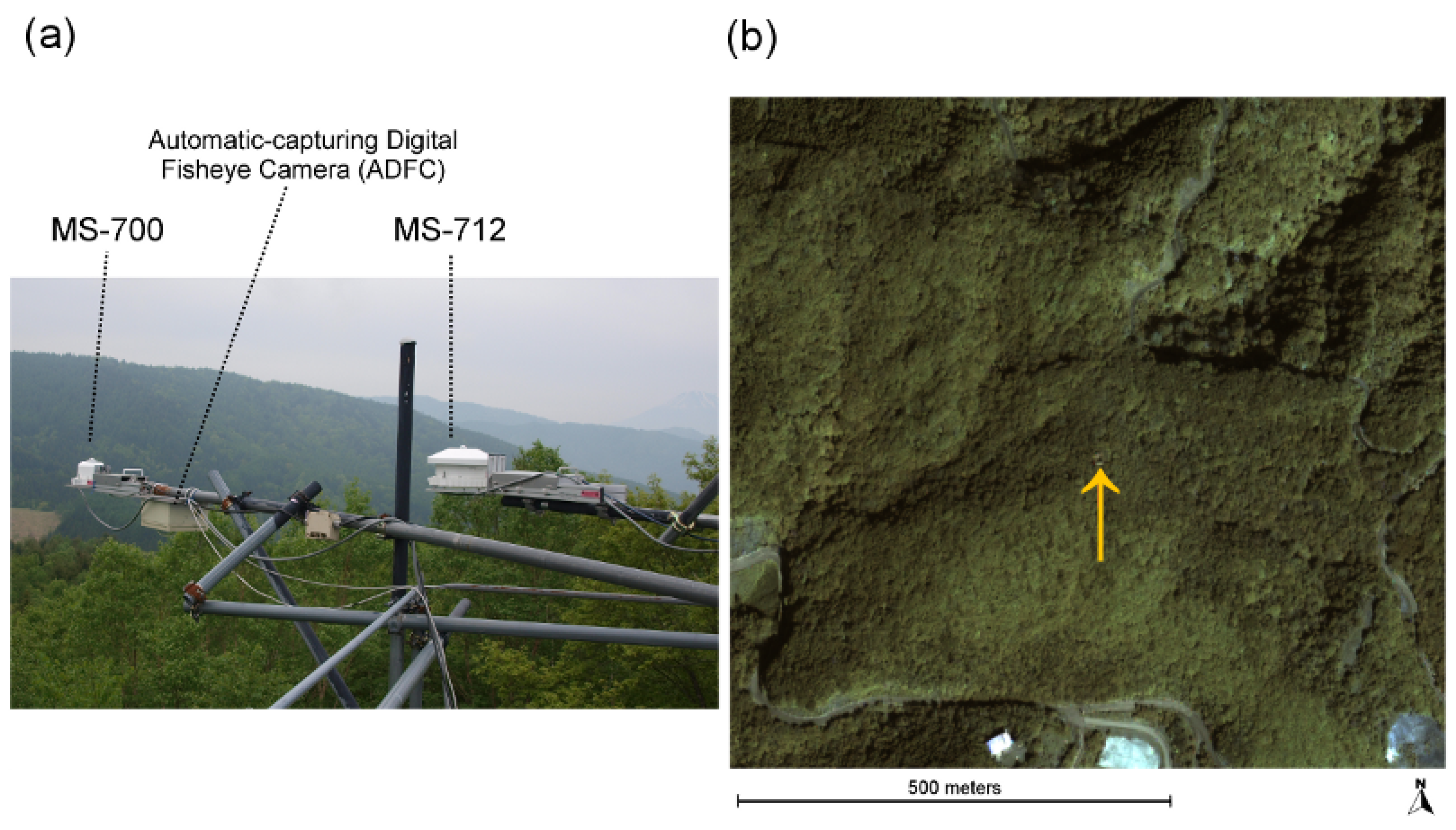
2.3. Calculation of Spectral Reflectance from in situ Data


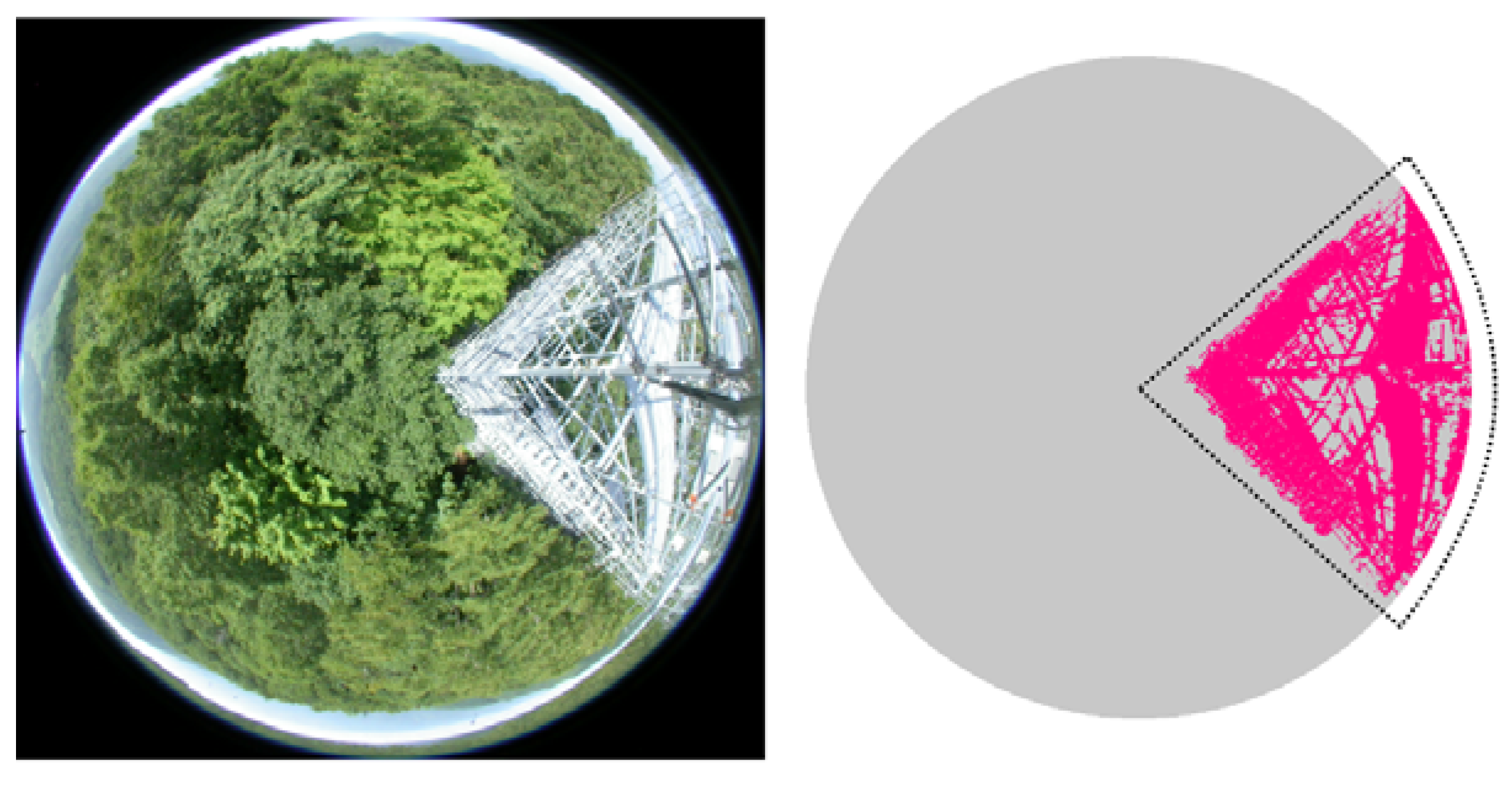
2.4. Processing of Terra/Aqua MODIS Data
2.5. Calculation of Spectral Indices
2.6. Cloud Coverage at the MODIS Overpass Time
- Category 1: cloud coverage of the sky was less than 20%;
- Category 2: cloud coverage was more than 20%;
- Category 3: cloud coverage was unknown because of missing ADFC images.

3. Results
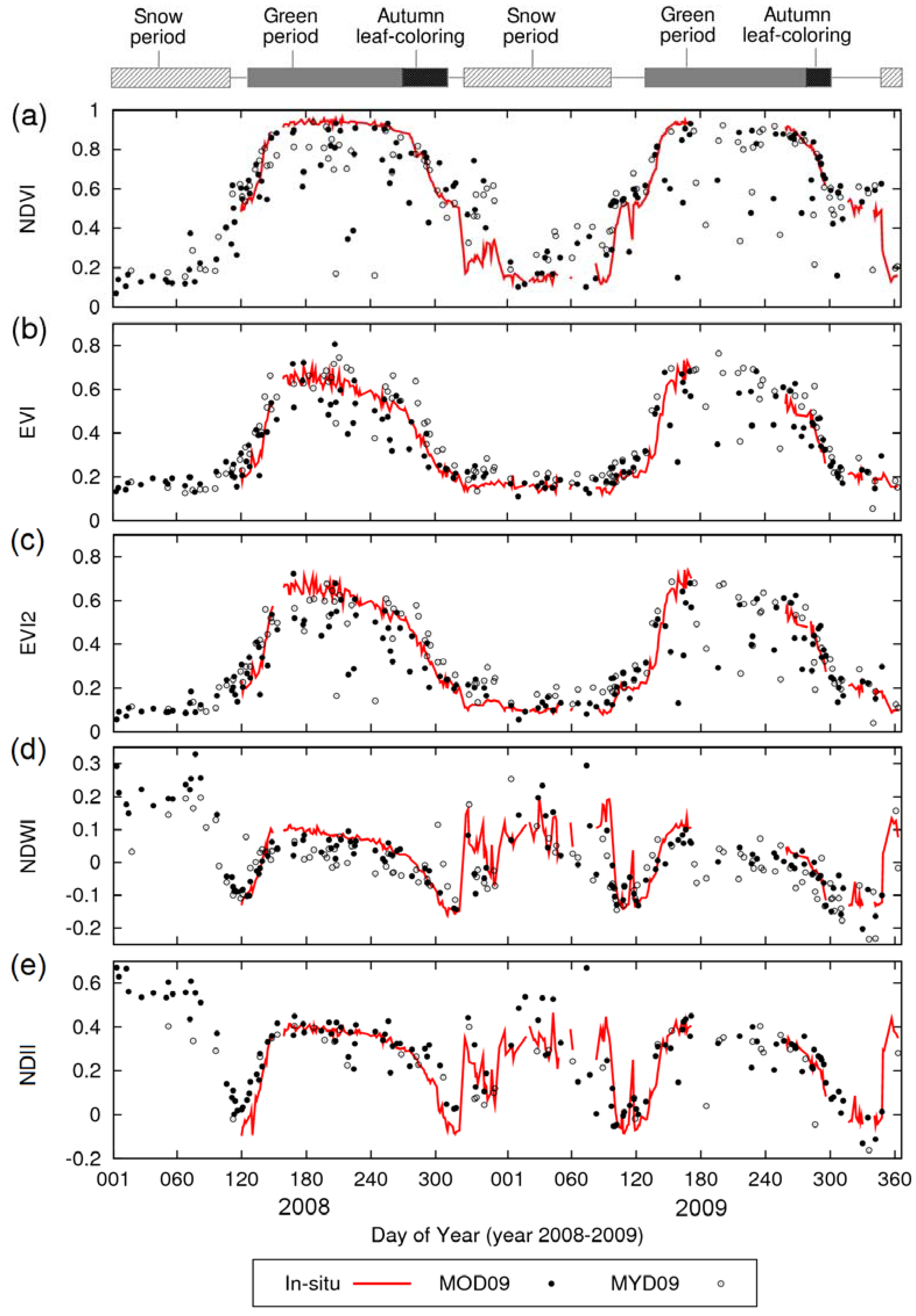

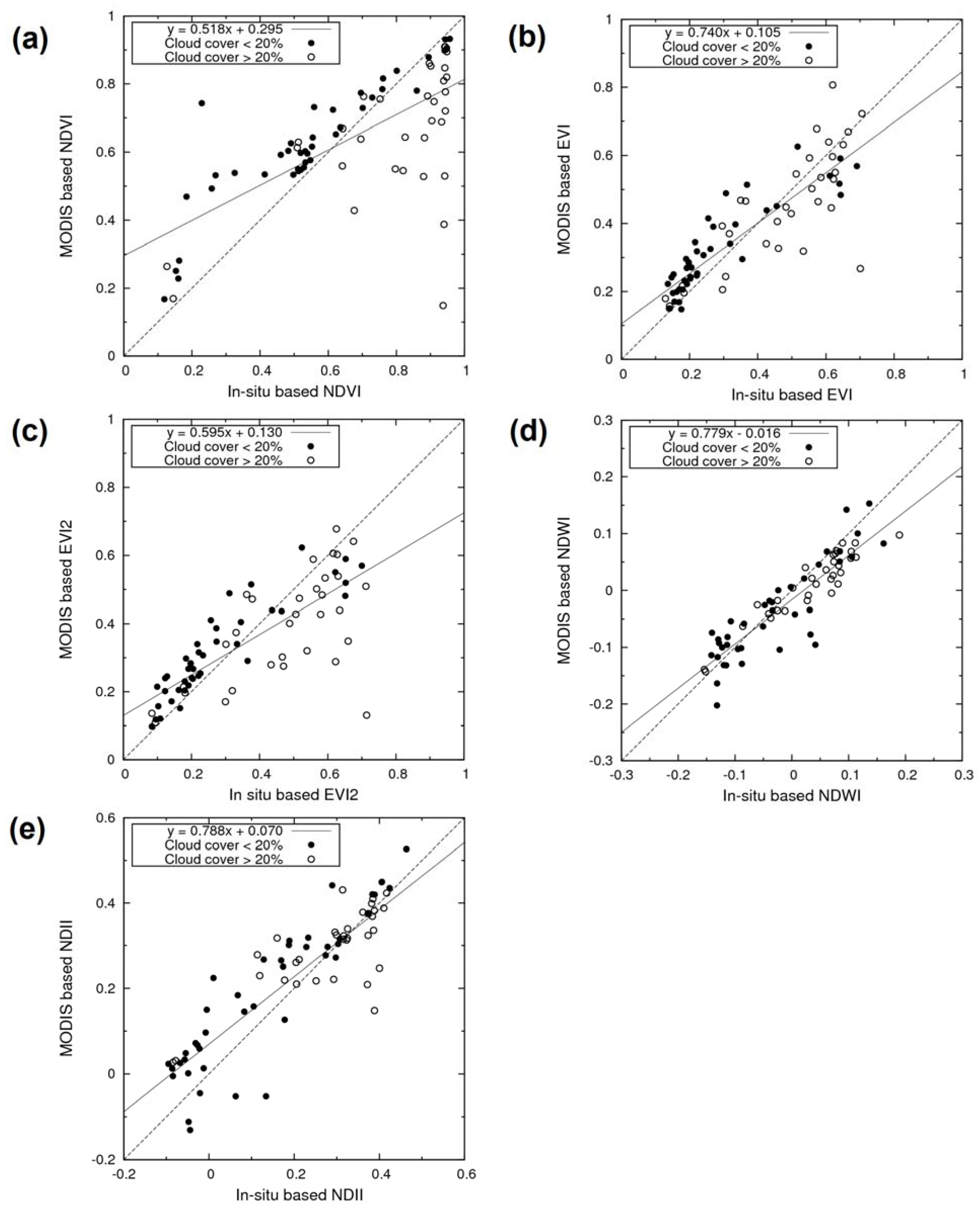
| Spectral Index | n | RRMSD | RMB | R2 | |
|---|---|---|---|---|---|
| NDVI | All data | 80 | 0.227 | −0.024 | 0.485 (p < 0.0001) |
| (1) Cloud cover < 20% | 42 | 0.156 | 0.093 | 0.826 (p < 0.0001) | |
| (2) Cloud cover ≥ 20% | 32 | 0.292 | −0.177 | 0.324 (p < 0.001) | |
| (3) No sky-image | 6 | – | – | – | |
| EVI | All data | 80 | 0.167 | 0.017 | 0.744 (p < 0.0001) |
| (1) Cloud cover < 20% | 42 | 0.150 | 0.070 | 0.793 (p < 0.0001) | |
| (2) Cloud cover ≥ 20% | 32 | 0.202 | −0.048 | 0.600 (p < 0.0001) | |
| (3) No sky-image | 6 | – | – | – | |
| EVI2 | All data | 80 | 0.199 | −0.027 | 0.622 (p < 0.0001) |
| (1) Cloud cover < 20% | 42 | 0.140 | 0.065 | 0.810 (p < 0.0001) | |
| (2) Cloud cover ≥ 20% | 32 | 0.266 | −0.141 | 0.413 (p < 0.001) | |
| (3) No sky-image | 6 | – | – | – | |
| NDWI | All data | 78 | 0.133 | −0.050 | 0.769 (p < 0.0001) |
| (1) Cloud cover < 20% | 39 | 0.150 | −0.029 | 0.755 (p < 0.0001) | |
| (2) Cloud cover ≥ 20% | 32 | 0.109 | −0.068 | 0.881 (p < 0.0001) | |
| (3) No sky-image | 7 | – | – | – | |
| NDII | All data | 81 | 0.164 | 0.047 | 0.729 (p < 0.0001) |
| (1) Cloud cover < 20% | 43 | 0.163 | 0.092 | 0.817 (p < 0.0001) | |
| (2) Cloud cover ≥ 20% | 32 | 0.170 | 0.015 | 0.552 (p < 0.0001) | |
| (3) No sky-image | 6 | – | – | – | |
4. Discussion
| MODIS bands | Average reflectance (SD) | ρc/ρg | ||
|---|---|---|---|---|
| Clear-sky (n = 89) | Cloudy (n = 212) | |||
| Visible | Band 1 (620–670 nm) | 0.049 (0.047) | 0.522 (0.528) | 10.5 |
| Band 3 (459–479 nm) | 0.041 (0.050) | 0.528 (0.541) | 12.8 | |
| Band 4 (545–565 nm) | 0.065 (0.047) | 0.533 (0.522) | 8.12 | |
| Infrared | Band 2 (841–879 nm) | 0.307 (0.075) | 0.593 (0.336) | 1.93 |
| Band 5 (1230–1250 nm) | 0.266 (0.081) | 0.531 (0.300) | 1.76 | |
| Band 6 (1628–1652 nm) | 0.160 (0.048) | 0.333 (0.215) | 2.08 | |
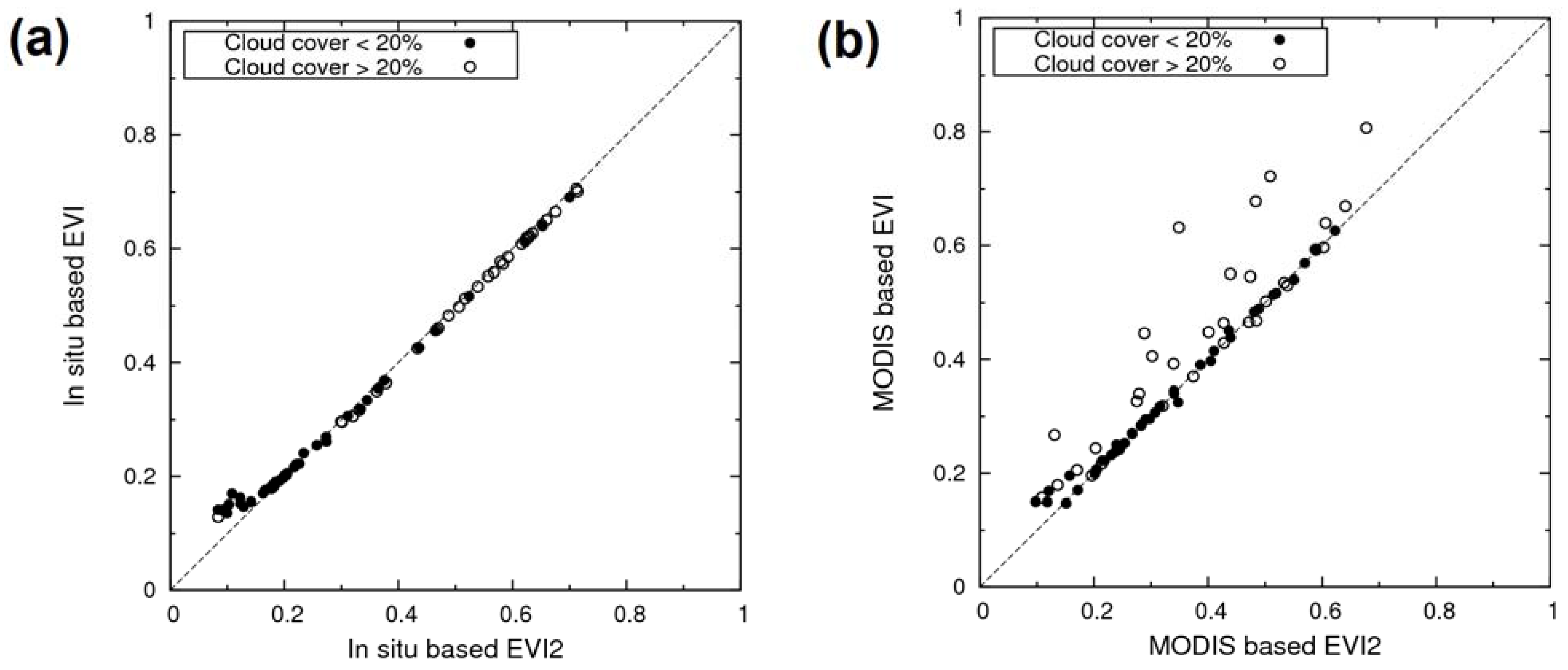
Acknowledgments
References
- Baret, F.; Guyot, G. Potentials and limits of vegetation indices for LAI and APAR assessment. Remote Sens. Environ. 1991, 35, 161–173. [Google Scholar] [CrossRef]
- Myneni, R.B.; Nemani, R.R.; Running, S.W. Estimation of global leaf area index and absorbed PAR using radiative transfer models. IEEE Trans. Geosci. Remote Sens. 1997, 35, 1380–1393. [Google Scholar] [CrossRef]
- Wang, Q.; Adiku, S.; Tenhunen, J.; Granier, A. On the relationship of NDVI with leaf area index in a deciduous forest site. Remote Sens. Environ. 2005, 94, 244–255. [Google Scholar] [CrossRef]
- Kobayashi, H.; Delbart, N.; Suzuki, R.; Kushida, K. A satellite-based method for monitoring seasonality in the overstory leaf area index of Siberian larch forest. J. Geophys. Res. 2010, 115. [Google Scholar] [CrossRef]
- White, M.A.; Thornton, P.E.; Running, S.W. A continental phenology model for monitoring vegetation responses to interannual climatic variability. Glob. Biogeochem. Cycles 1997, 11, 217–234. [Google Scholar] [CrossRef]
- Delbart, N.; Picard, G.; Le Toan, T.; Kergoat, L.; Quegan, S.; Woodward, I.; Dye, D.; Fedotova, V. Spring phenology in boreal Eurasia over a nearly century time scale. Glob. Change Biol. 2008, 14, 603–614. [Google Scholar] [CrossRef]
- Platnick, S. The MODIS cloud products: Algorithms and examples from terra. IEEE Trans. Geosci. Remote Sens. 2003, 41, 459–473. [Google Scholar] [CrossRef]
- Nagai, S.; Saigusa, N.; Muraoka, H.; Nasahara, K.N. What makes the satellite-based EVI-GPP relationship unclear in a deciduous broad-leaved forest? Ecol. Res. 2010, 25, 359–365. [Google Scholar] [CrossRef]
- Tucker, C.J. Red and photographic infrared linear combinations for monitoring vegetation. Remote Sens. Environ. 1979, 8, 127–150. [Google Scholar] [CrossRef]
- Holben, B.N. Characteristics of maximum-value composite images from temporal AVHRR data. Int. J. Remote Sens. 1986, 7, 1417–1434. [Google Scholar] [CrossRef]
- Viovy, N.; Arino, O.; Belward, A.S. The Best Index Slope Extraction (BISE): A method for reducing noise in NDVI time-series. Int. J. Remote Sens. 1992, 13, 1585–1590. [Google Scholar] [CrossRef]
- Cihlar, J.; Howarth, J. Detection and removal of cloud contamination from AVHRR images. IEEE Trans. Geosci. Remote Sens. 1994, 32, 583–589. [Google Scholar] [CrossRef]
- Jönsson, P.; Eklundh, L. Seasonality extraction by function fitting to time-series of satellite sensor data. IEEE Trans. Geosci. Remote Sens. 2002, 40, 1824–1832. [Google Scholar] [CrossRef]
- Kaufman, Y.J. The effect of subpixel clouds on remote sensing. Int. J. Remote Sens. 1987, 8, 839–857. [Google Scholar] [CrossRef]
- Huete, A.; Didan, K.; Miura, T.; Rodriguez, E.P.; Gao, X.; Ferreira, L.G. Overview of the radiometric and biophysical performance of the MODIS vegetation indices. Remote Sens. Environ. 2002, 83, 195–213. [Google Scholar] [CrossRef]
- Jiang, Z.; Huete, A.; Didan, K.; Miura, T. Development of a two-band enhanced vegetation index without a blue band. Remote Sens. Environ. 2008, 112, 3833–3845. [Google Scholar] [CrossRef]
- Gao, B.C. NDWI: A normalized difference water index for remote sensing of vegetation liquid water from space. Remote Sens. Environ. 1996, 58, 257–266. [Google Scholar] [CrossRef]
- Hardisky, M.A.; Klemas, V.; Smart, R.M. The influence of soil salinity, growth form, and leaf moisture on the spectral reflectance of Spartina alternifolia canopies. Photogramm. Eng. Remote Sens. 1983, 49, 77–83. [Google Scholar]
- Hunt, E.R.; Rock, B.N. Detection of changes in leaf water content using near- and middle-infrared reflectances. Remote Sens. Environ. 1989, 30, 43–54. [Google Scholar]
- Nakaji, T.; Ide, R.; Takagi, K.; Kosugi, Y.; Ohkubo, S.; Nishida, K.; Saigusa, N.; Oguma, H. Utility of spectral vegetation indices for estimation of light conversion efficiency in coniferous forests in Japan. Agr. Forest Meteorol. 2008, 148, 776–787. [Google Scholar] [CrossRef]
- Motohka, T.; Nasahara, K.N.; Miyata, A.; Mano, M.; Tsuchida, S. Evaluation of optical satellite remote sensing for rice paddy phenology in monsoon Asia using continuous in situ dataset. Int. J. Remote Sens. 2009, 30, 4343–4357. [Google Scholar] [CrossRef]
- Motohka, T.; Nasahara, K.N.; Oguma, H.; Tsuchida, S. Utility of Green-Red Vegetation Index for remote sensing of vegetation phenology. Remote Sens. 2010, 2, 2369–2387. [Google Scholar] [CrossRef]
- Nagai, S.; Nasahara, K.N.; Muraoka, H.; Akiyama, T.; Tsuchida, S. Field experiments to test the use of the normalized difference vegetation index for phenology detection. Agr. Forest Meteorol. 2010, 150, 152–160. [Google Scholar] [CrossRef] [Green Version]
- Ohtsuka, T.; Akiyama, T.; Hashimoto, Y.; Inatomi, M.; Sakai, T.; Jia, S.; Mo, W.; Tsuda, S.; Koizumi, H. Biometric based estimates of net primary production (NPP) in a cool temperate deciduous forest stand beneath a flux tower. Agr. Forest Meteorol. 2005, 134, 27–38. [Google Scholar] [CrossRef]
- Ohtsuka, T.; Mo, W.; Satomura, T.; Inatomi, M.; Koizumi, H. Biometric based carbon flux measurements and net ecosystem production (NEP) in a temperate deciduous broad-leaved forest beneath a flux tower. Ecosystems 2007, 10, 324–334. [Google Scholar] [CrossRef]
- Ohtsuka, T.; Saigusa, N.; Koizumi, H. On linking multiyear biometric measurements of tree growth with eddy covariance-based net ecosystem production. Glob. Change Biol. 2009, 15, 1015–1024. [Google Scholar] [CrossRef]
- Saigusa, N.; Yamamoto, S.; Murayama, S.; Kondo, H.; Nishimura, N. Gross primary production and net ecosystem production of a cool-temperate deciduous forest estimated by the eddy covariance method. Agr. Forest Meteorol. 2002, 112, 203–215. [Google Scholar] [CrossRef]
- Saigusa, N.; Yamamoto, S.; Murayama, S.; Kondo, H. Inter-annual variability of carbon budget components in an AsiaFlux forest site estimated by long-term flux measurements. Agr. Forest Meteorol. 2005, 134, 4–16. [Google Scholar] [CrossRef]
- Nasahara, K.N.; Muraoka, H.; Nagai, S.; Mikami, H. Vertical integration of leaf area index in a Japanese deciduous broad-leaved forest. Agr. Forest Meteorol. 2008, 148, 1136–1146. [Google Scholar] [CrossRef] [Green Version]
- Nishida, K. Phenological Eyes Network (PEN): A validation network for remote sensing of the terrestrial ecosystems. AsiaFlux Newsl. 2007, 21, 9–13. [Google Scholar]
- Steven, M.; Malthus, T.; Baret, F.; Xu, H.; Chopping, M. Intercalibration of vegetation indices from different sensor systems. Remote Sens. Environ. 2003, 88, 412–422. [Google Scholar] [CrossRef]
- Settle, J.J. Linear mixing and the estimation of ground cover proportions. Int. J. Remote Sens. 1993, 14, 1159–1177. [Google Scholar] [CrossRef]
- Jackson, J.T.; Chen, D.; Cosh, M.; Li, F.; Anderson, M.; Walthall, C.; Doriaswamy, P.; Hunt, E.R. Vegetation water content mapping using Landsat data derived normalized difference water index for corn and soybeans. Remote Sens. Environ. 2004, 92, 475–482. [Google Scholar] [CrossRef]
- Maki, M.; Ishihara, M.; Tamura, M. Estimation of leaf water status to monitor the risk of forest fires by using remotely sensed data. Remote Sens. Environ. 2004, 90, 441–450. [Google Scholar] [CrossRef]
- Chen, D.; Huang, J.; Jackson, J.T. Vegetation water content estimation for corn and soybeans using spectral indices derived from MODIS near- and short-wave infrared bands. Remote Sens. Environ. 2005, 98, 225–236. [Google Scholar] [CrossRef]
- Barnes, W.L.; Xiong, X.; Salmonson, V.V. Status of Terra MODIS and Aqua MODIS. Adv. Space Res. 2003, 32, 2099–2106. [Google Scholar] [CrossRef]
- Xiong, X.; Chiang, K.; Sun, J.; Barnes, W.L.; Guenther, B.; Salomonson, V.V. NASA EOS Terra and Aqua MODIS on-orbit performance. Adv. Space Res. 2009, 43, 413–422. [Google Scholar] [CrossRef]
- Delbart, N.; Kergoat, L.; Le Toan, T.; L'Hermitte, J.; Picard, G. Determination of phenological dates in boreal regions using Normalised Difference Water Index. Remote Sens. Environ. 2005, 97, 26–38. [Google Scholar] [CrossRef]
- Delbart, N.; Le Toan, T.; Kergoat, L.; Fedotova, F. Remote sensing of spring phenology in boreal regions: A free of snow-effect method using NOAAAVHRR and SPOT-VGT data (1982–2004). Remote Sens. Environ. 2006, 101, 52–62. [Google Scholar] [CrossRef]
- Ahl, D.E.; Gower, S.T.; Burrows, S.N.; Shabanov, N.V.; Myneni, R.B.; Knyazikhin, Y. Monitoring spring canopy phenology of a deciduous broadleaf forest using MODIS. Remote Sens. Environ. 2006, 104, 88–95. [Google Scholar] [CrossRef]
- de Beurs, K.M.; Townsend, P.A. Estimating the effect of gypsy moth defoliation using MODIS. Remote Sens. Environ. 2008, 112, 3983–3990. [Google Scholar] [CrossRef]
- Kushida, K.; Kim, Y.; Tsuyuzaki, S.; Fukuda, M. Spectral vegetation indices for estimating shrub cover, green phytomass and leaf turnover in a sedge-shrub tundra. Int. J. Remote Sens. 2009, 30, 1651–1658. [Google Scholar] [CrossRef]
- Dunn, A.H.; de Beurs, K.M. Land surface phenology of North American mountain environments using moderate resolution imaging spectroradiometer data. Remote Sens. Environ. 2011, 115, 1220–1233. [Google Scholar] [CrossRef]
- Houborg, R.; Soegaard, H.; Boegh, E. Combining vegetation index and model inversion methods for the extractionof key vegetation biophysical parametersusing Terra and Aqua MODIS reflectance data. Remote Sens. Environ. 2007, 106, 39–58. [Google Scholar] [CrossRef]
- Cheng, Y.B.; Ustin, S.L.; Riaño, D.; Vanderbilt, V.C. Water content estimation from hyperspectral images and MODIS indexes in Southeastern Arizona. Remote Sens. Environ. 2008, 112, 363–374. [Google Scholar] [CrossRef]
© 2011 by the authors; licensee MDPI, Basel, Switzerland. This article is an open access article distributed under the terms and conditions of the Creative Commons Attribution license (http://creativecommons.org/licenses/by/3.0/).
Share and Cite
Motohka, T.; Nasahara, K.N.; Murakami, K.; Nagai, S. Evaluation of Sub-Pixel Cloud Noises on MODIS Daily Spectral Indices Based on in situ Measurements. Remote Sens. 2011, 3, 1644-1662. https://doi.org/10.3390/rs3081644
Motohka T, Nasahara KN, Murakami K, Nagai S. Evaluation of Sub-Pixel Cloud Noises on MODIS Daily Spectral Indices Based on in situ Measurements. Remote Sensing. 2011; 3(8):1644-1662. https://doi.org/10.3390/rs3081644
Chicago/Turabian StyleMotohka, Takeshi, Kenlo Nishida Nasahara, Kazutaka Murakami, and Shin Nagai. 2011. "Evaluation of Sub-Pixel Cloud Noises on MODIS Daily Spectral Indices Based on in situ Measurements" Remote Sensing 3, no. 8: 1644-1662. https://doi.org/10.3390/rs3081644
APA StyleMotohka, T., Nasahara, K. N., Murakami, K., & Nagai, S. (2011). Evaluation of Sub-Pixel Cloud Noises on MODIS Daily Spectral Indices Based on in situ Measurements. Remote Sensing, 3(8), 1644-1662. https://doi.org/10.3390/rs3081644






